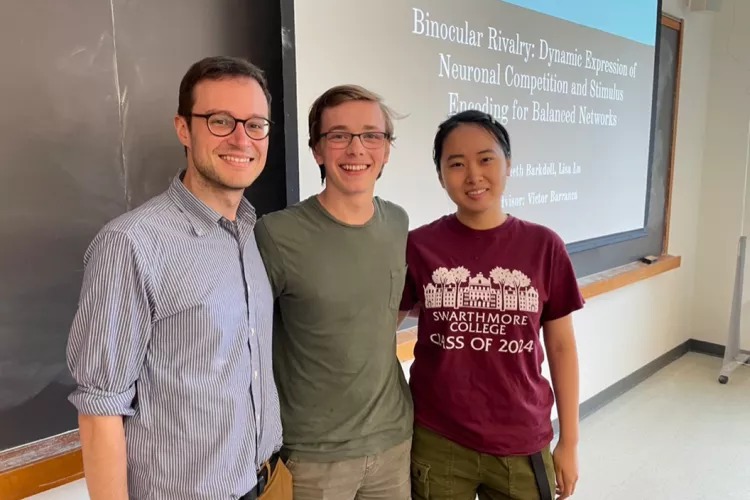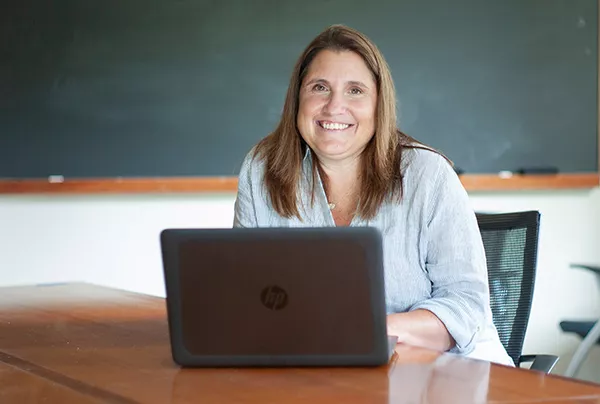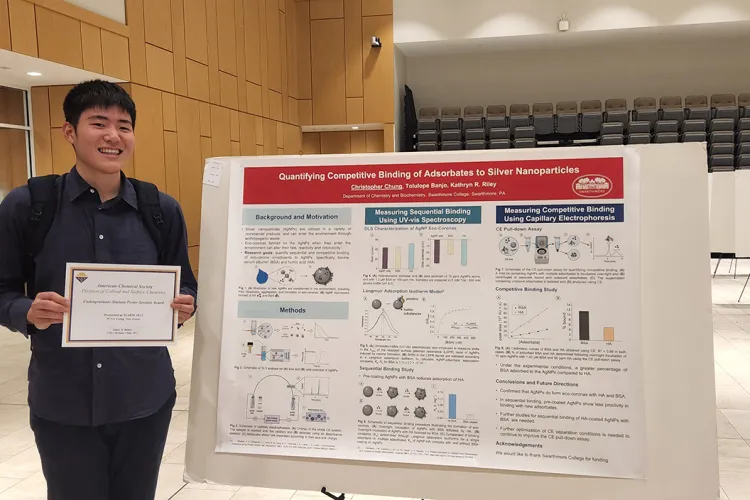The Thrill of Discovery

Associate Professor of Mathematics and Statistics Victor Barranca, Kenneth Barkdoll ’24, and Lisa Lu ’24 worked on a mathematical modeling view of binocular rivalry over the summer.
Year after year, Victor Barranca delights in collaborations with student researchers.
“I never cease to be impressed by how far Swarthmore students grow over just ten weeks in the summer,” says the associate professor of mathematics and statistics, referring to them as active research partners who end up driving the creative direction of the work.
“My hope is that students gain a real sense of ownership for their research,” he adds, “and fully experience the thrill of scientific discovery.”
Mission accomplished this summer, in which Barranca worked with Deven Ayambem ’24 and a Drexel University professor on a study of neuronal computations in the fly brain responsible for aggressive behavior. He also worked with Lisa Lu ’24 and Kenneth Barkdoll ’24 on a mathematical modeling view of binocular rivalry, which is the phenomenon that occurs when the two eyes are presented with very different images and the resulting visual percept (what you actually "see") randomly switches between the two images.
The students gain invaluable, hands-on experience with the scientific process — and, not for nothing, a head-turning answer to “How did you spend your summer vacation?"
“I learned so much about how to approach the process of debugging a complicated program, or troubleshoot an unexpected result,” says Lu, a computer science and math major from Shanghai. “The experience changed my perspective about the work and life of a researcher.”
Max Miller ’23, who joined Associate Professor of Economics Maria Olivero and Tiffany Jiang ’24 on a research project to expand financial services for underserved communities, echoed that thought.
“My biggest takeaway is that research is a very collaborative effort, but also that it is not a quick and easy process,” says Miller, an economics and Chinese major from Singapore, who reached out to Olivero for the research opportunity and contributed to it remotely. “Juggling more than one point of view is not always the easiest, but I have found it to be critical to coming up with the best possible output."
Olivero and her students examined households that lack access to formal financial services like bank credit, and therefore face tight credit restraints which may lead them to turn to payday loans or pawn shops. The team developed a comprehensive survey of the households’ experiences with the hope of guiding future policy-making.
“It was fascinating not only deciding what type of data we wanted [to collect] but the best way to ask our questions,” says Jiang, an honors economics and math major from China, who also reached out to Olivero about research opportunities. “The process showed me just how different economics research in the real world was compared to learning economic theory from a book.”
For her part, Olivero expected to spend a lot of time teaching the students the technical aspects of data management and use of statistical software packages. What she didn’t anticipate was how much the students would teach her.

Economist Maria Olivero and her students examined households that lack access to formal financial services like bank credit.
“They have forced me to think about some elements of my research in ways deeper than I ever had,” says Olivero. “They taught me newer tools and coding techniques and suggested different angles from where to look at my own research questions and new ways to motivate my work.”
Also working to serve a community — albeit from a discipline far, far away — was the research team of Associate Professor of Linguistics Jonathan Washington, Owen Pietsch ’24, Zach Kelly ’24, and Shannon Friel ’24. Supported by funding from a Faculty-Led Engaged Scholarship Research grant from the Lang Center as well as the College’s social sciences division, the collaborators created content for a community-facing language revitalization website and developed other resources for an extremely endangered Indigenous language of North America.
“Even more important than the skills and experience they gained, I really hope (and believe) the students understood how meaningful this work was, gained a sense of accomplishment from it, and came to understand new perspectives by engaging with our community partner,” says Washington. “In my mind, this project was the perfect intersection of applying skills the students already had, learning new ones, gaining practical experience, and being of service.”
Among other research collaborations between Swarthmore faculty and students this summer:
- Professor of History Diego Armus worked on several research projects with students, including with Gabriel Levis ’23 and Leo Hecht ’23 on a syllabus for a future course on soccer as a multifaceted global phenomenon, emphasizing its cultural, political, economic, national, and social issues.
- Visiting Assistant Professor of Political Science Osman Balkan supervised Alex Del Greco ’23 on independent research on the politics of names and naming in Central Asia and Russia.
- Assistant Professor of Biology Carolyn Bauer worked with three students, Kaja Arusha ’24, Maya Tipton ’23, and Daniela Kim ’23, who carried out research with captive degus (an endemic rodent) in central Chile this summer.
- Associate Professor of Biology Alex Baugh conducted field research in Minnesota on the mating behavior of frogs, with Callie Cho ’23, Daniel Oakes ’24, and Alice Onyango-Opiyo ’23.
- Morris L. Clothier Professor of Physics Michael Brown worked with Kya Butterfield '24 and Ayla Cimen '24 on experimental projects in the SSX lab and with Alex Skeldon '25 on state-of-the art computer simulations with the Pittsburgh supercomputer.
- Assistant Professor of Biology Karen Chan and Professor of Engineering Carr Everbach collaborated with students, including Eleanor Van Rheenen ’24 and Kennedy Hill ’23, on project funded by the National Science Foundation (NSF) to study the hydrodynamic impacts of long body extensions (horns, tails, and spikes) in marine plankton through the use of dynamically scaled models that include robotic flapping limbs.
- Associate Professor of Biology Bradley Davidson worked on research projects with several students, including Jasmine Yimeng Bao ’24, who initiated a project on heart regeneration.
- Walter Kemp Professor in the Natural Sciences and Professor of Physics Amy Graves worked with Jean Luc Ishimwe ’24 and Xiang Li ’24 on work supported by the National Science Foundation on supercomputers to study soft matter.
- Four faculty members from the Department of Chemistry and Biochemistry accompanied 19 students, all of whom did summer research, to the Middle Atlantic Regional Meeting (MARM) of the American Chemical Society in June, at which the students and faculty showcased 13 posters and eight discussions. Christopher Chung ’23, who works in the lab of Assistant Professor of Chemistry Kathryn Riley ’10, won the Undergraduate Student Poster Session Award for his poster “Quantifying Competitive Binding of Adsorbates to Silver Nanoparticles."

Christopher Chung ’23 won the Undergraduate Student Poster Session Award for his poster “Quantifying Competitive Binding of Adsorbates to Silver Nanoparticles."
- Visiting Assistant Professor of Peace & Conflict Studies Amy Kapit worked with two students on a project examining regression of student activism around the globe and one on work relating to humanitarian aid and education.
- Associate Professor of Sociology Daniel Laurison ’99 worked with seven students on full-time, College-funded research, and four other students working part-time, for his Politics and Equal Participation Lab, for which the team worked with seven community-based researchers.
- Assistant Professor of Statistics Amandy Luby worked with Sarah Conley '24 on a project to understand the performance and variability of fingerprint examiners in forensic science.
- Dorwin P. Cartwright Professor of Social Theory and Social Action K. Ann Renninger worked with students on several projects, including one on teachers' learning to integrate computer science in their mathematics teaching, which included several Swarthmore alumni, members of the computer science department at Brown University, and math educators at 21st Century Partnership for STEM Education.
- Assistant Professor of Mathematics and Statistics Ian Whitehead worked with David Yang ’24, Philip Rehwinkel ’24 and Philip Yang ’25 on a geometry research project.



